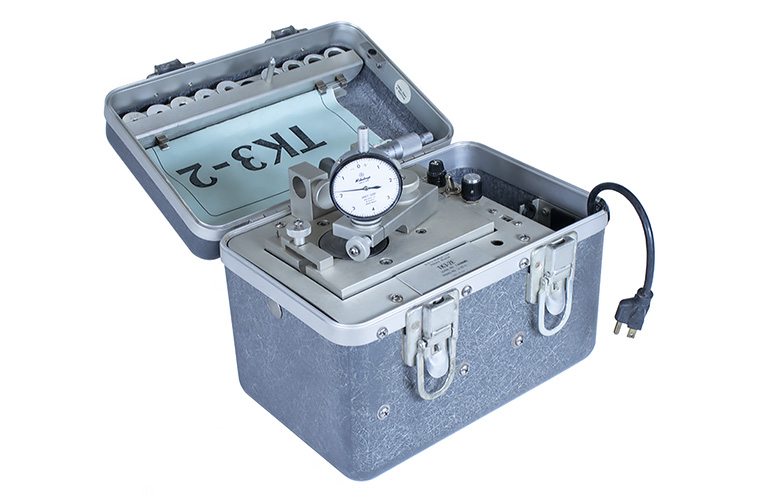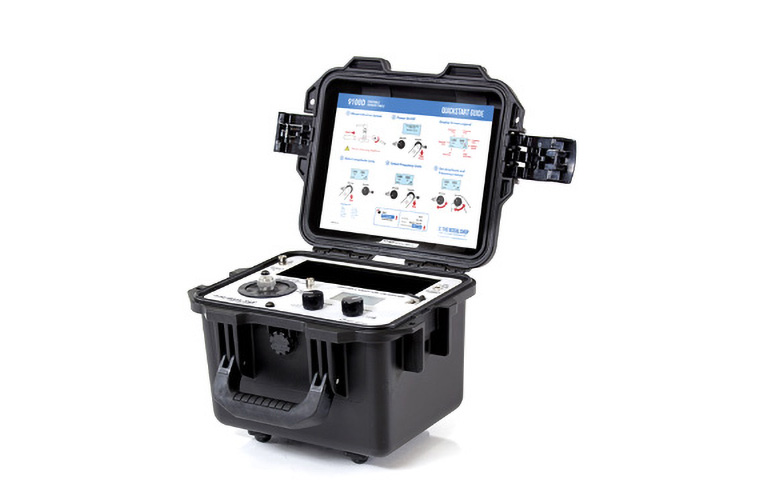Main Menu
- Home
- Product Finder
- Calibration Systems
- Calibration Services
- Digital Sensing
- Industrial Vibration Calibration
- Modal and Vibration Testing
- Non-Destructive Testing
- Sound & Vibration Rental Program
- Learn
- About Us
- Contact Us
The Modal Shop’s Portable Vibration Calibrator shaker table is often referred to as a wobulator or wobble plate. Although the Portable Vibration Calibrator is a useful tool for calibrating and loop-checking proximity probes, it is not actually a wobulator. The wobulator is a clever device that’s been around for decades. The Modal Shop's portable shaker is ideal for checking and calibrating accelerometers, velocity transducers, proximity probes, and more. Both simulate shaft vibration for testing proximity probes, detecting cabling errors, and verifying the proper operation of alerts and alarms through an entire measurement chain.
So, what are the major differences? A key advantage of using a Portable Vibration Calibrator instead of a wobulator for proximity probe end-to-end testing or calibration is ease-of-use. The technician can complete 10-point tests in a matter of minutes. No more spinning a plate with a finger to adjust displacement – instead set displacement electronically with the turn of a dial. Take a look at the chart below for more details.
| Bently Nevada™ "Wobulator" TK-3 or TK3-2E | The Modal Shop Portable Vibration Calibrator 9100D or 9110D |
|---|---|
 |  |
| Used only to Test Proximity Probes | Tests proximity probes, accelerometers (IEPE, charge, current line drive and modulated current), velocity transducers (seismic, moving coil self-generating, 4-20 mA transmitters, etc.) |
| Motor-driven wobble plate | Driven by electrodynamic shaker controlled via quartz reference accel (NIST traceable) |
| 1.00" (25 mm) static range using micrometer spindle | 1.00" (25 mm) static range using micrometer |
| Up to 10 mils (254 μm) dynamic range using wobble plate | Up to 50 mils (1270 μm) dynamic range using shaker |
| Runs on compressed air or line power | Runs on battery (up to 18 hrs) or line power via universal charger |
| Removable spindle micrometer assembly | Different adaptors support proximity probes with threads ranging from ¼" to ¾" (5 mm to 18 mm) including probes in ½" stinger sleeve housing, such as 9100‑PPA01 or ‑MPPA01, ‑PPA03, ‑PPA05, ‑PPA11, ‑PPA16, and 9100‑PPASH |
| Static curves are done manually | Static curves are entered manually in the supplied Microsoft Excel® workbook |
| Dynamic curves cannot be created | Dynamic linearity and frequency response curves are created semi-automatically using the supplied Microsoft Excel® workbook (no manual data entry) |
| ––– | Programmability of repetitive tests (CalRoute) using the supplied Microsoft Excel® workbook |
| ––– | Pass/Fail indication (only 9110D) |
| ––– | Sensitivity displayed in real time (only 9110D) |
| Relies on voltmeter or dial gauge for dynamic vibration setting | Closed-loop control eases the setting of speed and amplitude |
| ––– | Memory for CalRoute (6 tests) and saves 500 calibration records, exports via USB drive |
| API-670 compliant static curves Optional NIST-traceable dial micrometer for known dynamic displacement measurement | API-670 compliant static curves, NIST traceable calibration certificates using the supplied Microsoft Excel® workbook via ISO 16063-21 methodology |
| ––– | Supplied with A2LA accredited to ISO 17025 calibration certificate |
| ––– | Enables on-site calibration and connection to reference accel for sensitivity check and drift |
Bently Nevada is a trademark of Bently Nevada, Inc., a wholly owned subsidiary of General Electric Company. Excel is a registered trademark of Microsoft Corporation in the United States and/or other countries.